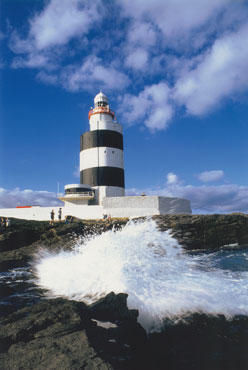





© 2021 www.dunmoreeast.net. All rights reserved Last updated 26 December 2021


Dunmore East is a small fishing village on
the south-east coast of Ireland, 16kms from
the city of Waterford.
It sits on the western side of the Waterford
Harbour Estuary, 4.8kms from Hook Head in
Wexford.
Dunmore East, Co. Waterford,
Ireland

Stories
We've all heard the expression "by hook or by crook", but where did it originate?
"I will take Ireland by Hook or by Crooke",
said Oliver Cromwell when he instructed his captains to land
ships at Hook Head or Crooke village, further up the estuary.
The following is an article taken from the Scotsman newspaper
in 2003:
Discovery of Cromwell's flagship rivals the Mary Rose
NICOLA BYRNE
WHEN it sank in the ‘graveyard of a thousand ships’, the Great
Lewis was the pride of Oliver Cromwell’s fleet.
During a mission to recapture a fort near the Irish port of
Waterford from Royalist forces in 1645, Cromwell’s flagship was
sent to the bottom of the sea by a combination of enemy
cannon and the rocky coastline.
Now archaeologists believe they have found the wreck and have begun to bring up the first
artefacts.
Historians are already comparing its importance to the discovery of the Mary Rose, Henry
VIII’s flagship, which sank near Portsmouth exactly 100 years before.
Cromwell’s attack on Waterford, which involved three other ships, gave rise to a famous
saying when the Lord Protector declared he would take the town "by Hook or by Crook",
referring to the two headlands which surround it.
It is not known yet what the remains of the Great Lewis will yield, but along with skeletal
remains of some of the crew and 200 soldiers on board, divers expect to find artillery and the
personal booty of the ship’s skipper, Captain Beale.
The National Maritime Museum at Greenwich said the find was very important.
Brian Lavery, curator of naval history at the museum, said: "Our knowledge of ships of this
period is so limited, a discovery like this is very exciting.
Any clues she has to offer about her era will be very welcome."
The Great Lewis’s mission failed miserably when a battery of guns from the Royalist-controlled
Duncannon fort turned on the attacking fleet, which also included the Mayflower, Elizabeth and
Magdalen.
The latter three managed to escape, but the Great Lewis, caught by adverse tides and winds,
floundered and sank after her masts were shot down.
She now lies just eight metres below the surface of the water in the main shipping lane of
Waterford harbour, one of the busiest in Ireland.
Local fishermen in the area said they had known for years about the wreck, but it was not until
the area was being dredged in 1999 that it first came to the attention of archaeologists.
Its precise location was pinpointed in 2001 and inspections of the wreck have since been
carried out by a private company on behalf of the Port of Waterford.
Divers from the Irish heritage service, who have spent the past two weeks carrying out
underwater surveys of the shipwreck, said they were excited about their preliminary findings.
Connie Kelleher, one of four underwater archeologists employed by the Irish government,
said: "When we heard about the wreck, we suspected it was the Great Lewis and everything
still seems to point in that direction.
"So far we’ve found decking and timber lined with leather which was a feature of the period
and we’ve also uncovered canons."
The County Waterford coastline holds an abundance of shipwrecks. And the shore around
Hook Head in particular boasts so many that the area is known as the ‘graveyard of a
thousand ships’.


















